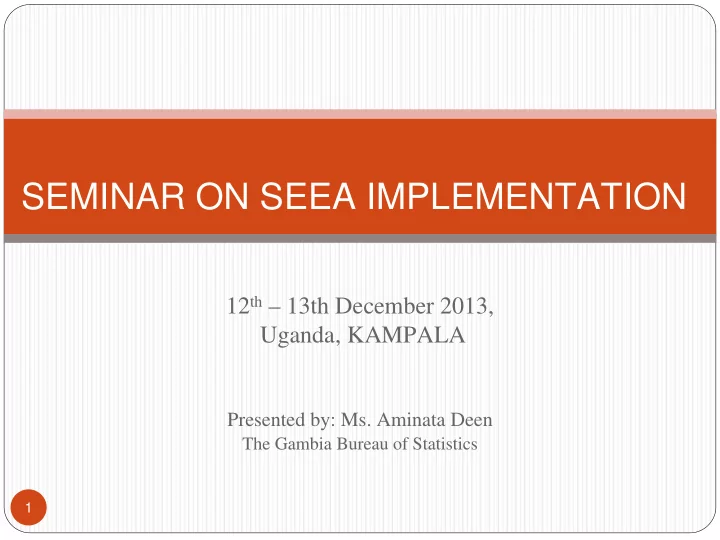

SEMINAR ON SEEA IMPLEMENTATION 12 th – 13th December 2013, Uganda, KAMPALA Presented by: Ms. Aminata Deen The Gambia Bureau of Statistics 1
Outline of the Presentation � Introduction: Demography & Physical Location � State of the Environment � Policy Issues � Relationship with National Accounts: • Conclusion/Wayforward 2
Demography & Physical Location � The Gambia lies in the West of Africa 15 o longitude at equal distances from the Equator and the Tropic of Cancer. It has area of 11,000 km 2 and is bounded by Senegal to the North, South and East and by the Atlantic Ocean to the West. � The Gambia has a sahelian type of climate characterised by a long dry season from mid- October to early June and a short rainy season from mid-June to early October. 3
Demography & Physical Location � Between the 1993 and 2003 censuses, population growth rate was 2.7 percent per annum and inward migration 1.3 percent resulting from the influx of refugees. At present, population growth is estimated between 3 and 4 percent per annum. � Access to safe drinking water is high in the Gambia. About 80% of the population have access to safe drinking water and about 90% has access to sanitary means of excreta disposal. 4
State of the Environment � The increasing demand for forest products particularly fuel wood for household energy is alarming. It is estimated that 70% of all household energy in the country depends on wood energy for cooking and the past three decades have witnessed the ecosystems bio diversity resources being subjected to misuse and over exploitation. � The demand by this large population on the natural resources base in terms of fuel wood supplies, construction materials, food production and other needs, put Gambia’s natural resources under great 5 strain.
State of the Environment � The main causes of a vicious cycle of forest destruction are the annual uncontrolled bush fires in combination with other human activities in particular, the practice of shifting cultivation, commercial exploitation of fuel wood and clearing of wetland catchment; � Records of coastal erosion impact in The Gambia date from the 1950's in the southern coastal region seriously affected; � Natural disasters such as droughts and floods are also issues of environment in the Gambia. 6
Policy Issues � A Declaration thus called loudly for actions to address environmental and natural resources management issues. � The Ministry’s Environment Unit was then established in 1982 to coordinate environmental matters and monitor the impact of various projects as well as to provide advice to Government and Non-Governmental Organisations. � The enactment of the National Environmental Management Act (NEMA) by Government in 1987 and the establishment of the National Environmental Management Council (NEMC) provided both the legal 7 framework for environmental planning, management
Policy Issues � These arrangements led to very intensive and highly- participatory approach in the preparation of the Gambia Environmental Action Plan (GEAP), thus providing a national framework to address environmental and natural resources management concerns. � The Phase I of the GEAP, from 1992 to 2001 was adopted with the creation of the National Environment Agency (NEA) in1993, was of pivotal importance in its commitment to a sustainable management of the country’s environment. 8
Relationship with National Accounts � The GEAP was now set to improve economic performance and quality of human life and restore, maintain and enhance ecological processes, natural resources, and cultural and natural heritage. � The whole man-made and natural asset was thus evaluated in 1996 and a second evaluation and preparation for Phase II was carried out in 2001. The GEAP remains a viable and functional approach to sustainable development. 9
Conclusion � The UNSD in collaboration with AU and ECOWAS has assisted countries in Africa so that they can have regular data for the ‘Green Accounts’ or more precisely data for the System of integrated Environmental and Economic Accounting (SEEA) 10
Way forward � The cost of depreciation of natural assets can be used to adjust the conventional GDP as to arrive at an environmentally adjusted Net Domestic Product. This is a useful measure of sustainable development. � There is a need for the focal person in charge of environmental statistics to closely work closely with the National Accounts unit in order to provide an integrated analysis of environmental issues in the Gambia taking into account all three pillars of sustainable development, namely social, environment and economic. 11
End of Presentation Thank you for your attention 12
Recommend
More recommend